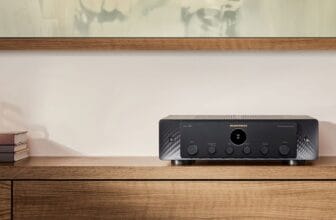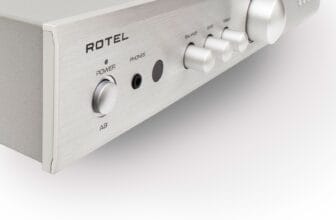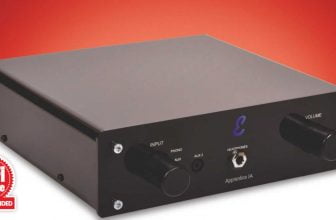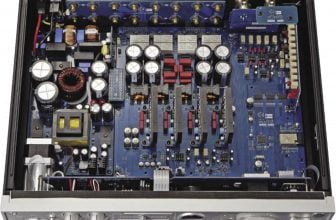Chord Electronics Anni Review
Back in 2018, Chord Electronics launched a DAC called the Qutest. It’s goal was simple; a small, straightforward digital converter designed to sit on a desk-top between your computer and your amplifier to deliver the best, no-nonsense sound possible at a reasonable price. It was joined in early 2020 by the Huei phono stage. It’s goal was simple to; a small, straightforward MM/MC phono stage designed to sit on a desk-top between your turntable and your amplifier to deliver the best, no-nonsense sound possible at a reasonable price.
by Alan Sircom
Are you starting to see a pattern here?
Now, Chord Electronics completes the group with the Anni integrated amplifier and it’s goal is the same as the Qutest and the Huei. All three share the same form-factor, a ‘none more black’ solid rectangular box with finger indents for the colour coded ball-like push-buttons that form most of its operational actions. Aside from the knob on the front and the absence of a glowing blue window in the top (Anni uses perforated holes to dissipate heat instead) they are almost identical and they look good laid side by side. Anni also includes a power feed to the Qutest and Huei and if you are using all three, a (modular) Qutest System Stand (QSS) that allows stacking. Given there were just two products in the range until now and the Anni has just the two inputs and no preamp outputs, don’t expect many more additions to the range.
Anni also explains why Chord Electronics’ small army of personal audio users scratched their heads at the omission of a headphone amp section in the Qutest… it’s here in the Anni. Anni gives you the choice of a 3.5mm and 6.35mm jack sockets on the front panel. These are not independently controllable and there is no balanced output option, but the Anni is not directed toward the seasoned headphonista, more someone who wants to extend their desktop system into something more potent. To that end, I suspect there will be a lot more Qutest+Anni combinations sitting next to a computer on a desk than there will be full-stack Qutest+Anni+Huei as a small replacement for a domestic stereo system. Not that the Anni isn’t capable of such a replacement, just that the lack of remote and relatively low output weigh against it.
Anni may be small, but don’t be fooled… there’s a lot of ‘clever’ inside that small box. We’ve been charting Chord Electronic’s move to its ULTIMA amplifier technology for some time now (since the Etude from 2018 in fact, which we reviewed in issue 168). To recap, this is a dual-feed-forward error-correction amplifier circuit topology based on a paper by Dr Malcolm J Hawksford’s (emeritus professor at Essex university), and the resultant design was developed in the 1980s by Bob Cordell of Bell Labs. Cordell’s design had a then- unprecedented 0.001 per cent total harmonic distortion at 20kHz. It does this by intelligently adjusting and compensating for the individual linearity of the output devices. Unfortunately, this degree of compensation placed the circuit out of reach for designers in the era of Big Hair and pastel-coloured suits with rolled-up sleeves. The amplifier circuit all-but disappeared as a result. However, Chord Electronics’ secret nerd-cave beneath that Pumphouse in Kent is a treasure-trove of forgotten audio papers. Chord Electronics saw the value in developing this one, and the ULTIMA range was born.
Anni shows just how scalable that ULTIMA circuit can be. The bigger ULTIMA stereo and mono amps can pump out up to a little more than one horsepower per channel and do so in a big chassis. Anni goes in the other direction, delivering a more modest 10W per channel into eight ohms. However, in a small setting with moderately efficient stand-mount speakers operating in the near-field, 10W is comfortably loud, and the Anni is deceptively powerful. Once again the absence of remote control tends to make the Anni one of those products that stays at arm’s reach. That generally means ‘desktop’.
In fact, Anni includes a two-stage ‘Gain’ setting on the top panel, next to the power button. Press and hold the Gain button and you switch the amplifier between high and low gain. This is useful because the volume control can be either too sensitive or too insensitive when mis-matched with the loudspeakers. If it is either of these things, a two-second press of the gain button and the glowing button flips between blue (for low gain) or red (for high). The moment you plug in a pair of headphones, however, the amp defaults to low gain; the button glows purple if in high-gain mode for the duration.

Colour-coding has been a thing with Chord Electronics since the original Hugo DAC, and that continues with the Anni. Alongside the blue/red/purple Gain button, the power button glows green for power-up/headphone mode, red for standby and cyan for regular operation. The volume control doubles as a channel selector, with the ring of LEDs changing from blue (input one) to red (input two). The ring of lights does not change to denote volume level, however. Finally from the front, inside the ventilation holes on the left hand top and front, there are red and green LEDs running whenever the amp is powered up (irrespective of settings; they are diodes, remember, they are doing diode stuff and happen to be doing it from a position of light emitting). There’s also an echo of the blue or red LEDs from the front panel. If you add in a Cutest and a Hue!, you get something of an undimmable Christmas tree of an audio electronics rig, but in truth, unless your audio equipment is in your bedroom, it’s not obtrusive. In an ideal world, however, I’d opt for a ‘lights off option, or at least a significant reduction in lights on show in standby. No biggie, though.
Seeing ventilation holes on the left hand side of the case did make me initially concerned; Anni is a very small, densely packed box and I was a bit reticent in letting it warm up straight out of the box in case it ran hotter than the surface of the Sun warm. But I put it through its paces even through the brief Indian Summer in early September and it never ran more than warm to the touch. The amplifier circuit, for all its low power is surprisingly willing to drive all but the most difficult loudspeaker loads. This is somewhat self-limiting; loudspeakers that would really challenge the Anni are priced far beyond any reasonable expectation of partnership, and a quick survey of products more likely to be used with the Anni nets absolutely nothing that would in any way cause a kerfuffle. Note: please don’t consider that as ‘challenge accepted’ and try to scare the Anni into submission by trying to play loud dub reggae through a pair of old Apogee Scintillas. But as discussed earlier, using it with real-world products in the same bail-park as the Chord Electronics amp; I used KEF’s LS50 Metas with Anni and they quickly became firm friends.
“The great thing about Anni in both build and sound quality terms is it never once makes you think it’s a small amplifier.”

As with the other products in this three-strong line, hooking it all up is a little fiddly because you are very short on rear-panel real estate. This is compounded by the use of the DC output to feed a Huei or Cutest. You are restricted to 4mm banana plugs (they insert deep into a recess on the rear panel, so there’s no provision for bare wire or spade lugs and even BFA connectors are not an option).
There is also a ground terminal provided, but frankly I’ve no idea why it’s there; the amp runs whisper quiet, I couldn’t get any kind of hum or increased noise floor out of Anni. While this terminal is a boon to those wanting to run grounding boxes, I can’t help but think this is a little esoteric for Anni’s potential customers. Chord Electronics doesn’t throw any light on its inclusion in the folded card manual provided. Like Anni itself, this is useful, if minimalist in approach. Chord Electronics does suggest that if used with a Cutest, remember to keep its output below 2V. The Cutest’s and Huei’s twin XLR outputs are not replicted as inputs here.
I’m generally not big on discussing packaging, but credit where it’s due; Chord Electronics really know how to make the unboxing of the Anni a bit special. It’s sleeved in black card matching the box itself. The front of the box has a small magnetic clamp to prevent the contents of the box tipping out everywhere. Once you lift that, you are met with a two-layer case, with the Anni sitting in a foam inset at the top, and a pull-out tray holds the power supply and cables.
Power is fed from an external 15V switch-mode supply, connecting to the Anni via a four-pin mini-DIN connector. Continuing the ‘wow, that’s good packaging’ tip, a little black drawstring bag in the bottom drawer includes a custom cable (called the Cutest range power adaptor) that connects the 12V output of the Anni to the Huei, and a short USB A to mini USB cable is included that connects the Cutest to the USB socket on the custom cable. Note that if you only have an Anni and a Cutest, there is a spare 12V power connector roaming free around the back of your system.
The great thing about Anni in both build and sound quality terms is it never once makes you think it’s a small amplifier. This is a big and clean sounding amplifier with an excellent soundstage and a keen sense of rhythm that no one had the heart to tell it quite how small it really was. So it sings its little heart out. In fact, when you hear Anni at work, saying things like ‘it sings its little heart out’ are at once trite and patronising. Anni don’t need your sympathy!
1OW is surprisingly gutsy too. OK, so this isn’t The Who’s Live At Leeds [Decca] album played at ‘Dude, Where’s My Hearing?’ level gutsy, but it’s more than meaty enough to play rock and dance music at ‘healthy’ levels without strain.
In fact, ‘without strain’ is something of an oft-repeated phrase with Chord Electronics’ Anni. Not simply that the amplifier rarely strains, even when undergoing some fairly heavy lifting amp-wise, not even because the sound has ►
“Chord Electronics’ Anni is a surprising amplifier. It has pushed the envelope of what a good, amplifier in this category can do.”
► something of that effortless, unfatiguing quality to it. I promised myself that I wouldn’t do this, but playing ‘It’s a Hard-Knock Life’ from Annie [Original Broadway cast soundtrack, Tidal] really showed this ‘without strain’ property to the amplifier’s sound. It’s a well recorded soundtrack (as many are) but the children’s voices can screech. Products that tame the screech often end up making the other parts of the recording too soft, while others make the kids sound too ‘squawky’. Anni’s ‘without strain’ quality makes the song well balanced, with the brass bass line easily picked out against the vocals. Annie works with Anni.
It helps that the soundstage is wide, too. There’s a little fro nt-to-back shortening and not much height information, but the width and precision of that soundstage works really, really well in the context of amplifiers at this level. Playing Carla Bley’s composition ‘Vashkar’ by the Marcin Wasilewski Trio [En attendant, ECM, Tidal] showed this well. The piano and upright bass were perfectly positioned in space, with the drum kit sitting not quite as far back in the mix as possible.
Bass is ‘taut’ rather than ‘cavernous’ or ‘stentorian’, but I like its snappy precision and it’s not without some heft. It’s more a ‘dry’ bass rather than the sort of big, overblown bottom end. Staying with the same ‘En attendant’ album, ‘In Motion Pt 2’ starts with a subtle drum solo followed by bass lines that demand detail, but in a very musical, rhythmic manner. Anni fares really well here. You get a real sense of players riffing off one another, and although that tempo is hard to determine at times, the Anni is good at getting its groove on and making that music flow in both a legato manner but also by teasing out the beat.
Most significantly, however, is Anni’s ability to portray musical detail with ease. It’s at this point you really have to take stock of the fact this is an amplifier intended to be used at arm’s reach, rather than in a full-sized system. You are hearing deep into the music with the Chord Electronics amplifier, extracting those nuggets of detail usually lost in the noise floor at this level. Those little but absolutely crucial key-depress noises, fretbord squeaks and more that put you there in the room with the musicians. All there in vivid detail. Excellent!
It’s only when you really push it does Anni begin to falter, hardening up in the treble first then down into the midrange, but even then it’s mostly an elegant faltering rather than a faceplant. And yes, if you go head-to-head with a larger, more powerful and more expansive amplifier in a conventional system, the hardening process starts at only beyond average listening levels, but we might be missing the point here.
What I found with Chord’s Anni is I almost instinctively treated it as if it were a conventional stereo integrated amplifier, rather than a desktop device. If you think of it in the desktop device space, the Anni is a real winner. My concern here, however, is more philosophical than critical per se; Anni is a logical extension of the Cutest and Hue! models, but where they act as small DACs or phono stages in a bigger system, Anni completes the system, and I’m wondering if the market for that system in the desktop is really that developed. Through no fault of Anni, it might be entering a market that does not yet exist. That being said, Anni is good enough to help create and develop that market for high-performance desktop separates.
Chord’s Anni is a surprising amplifier. It has pushed the envelope of what a good amplifier in this category can do, and it also shows that putting a good amplifier circuit in a small box is a practical solution, without having to resort to the strictures of products like gainclones (remember them?). Those who can never see past the 10W or the small box are missing a treat. This is a full-sized amplifier that lives in a desktop shaped box! +
TECHNICAL SPECIFICATIONS
Type: Desktop Integrated Amplifier
Power output; 10W per channel
THD+N: 0.02%
Signal to Noise Ratio: -11 OdB
Frequency Response: 5Hz-60kHz
Dimensions: 4.5cm (H) 1 6cm (W) 8.8cm (D)
Weight: 770g
Manufacturer: Chord Electronics
Tel: +44(0)1622 721444





